In pictures: Astronomy Photographer of the Year 2017
The winning images from this year's competition have now been announced, with Artem Mironov's vibrant clouds of dust and gas in the Rho Ophiuchi Cloud Complex scooping first place.

Stars and Nebulae
Mironov won both the Stars and Nebulae category and the overall award, Insight Astronomy Photographer of the Year 2017. This image was taken over the course of three nights at a farm in Namibia, near Gamsberg mountain.
The nebula is approximately 400 light years away from our planet, yet it is one of the closest to the Solar System.
 Artem Mironov
Artem Mironov Competition judge and astronomer Dr Marek Kukula said: "There's an astonishing richness of colour and structure in this gorgeous image.
"It's a popular part of the sky for astrophotographers, but this image shows it to us in a fresh light and there's a sense of mystery in the churning clouds of gas and dust."
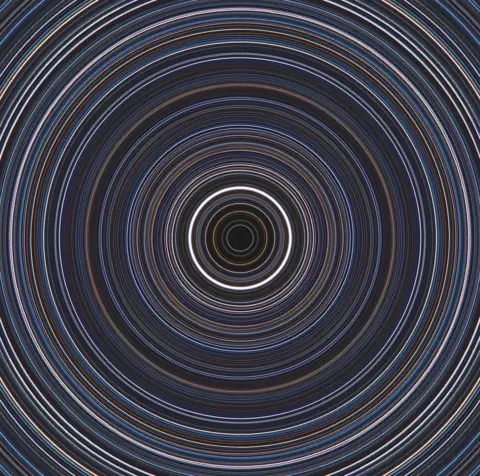 Andras Papp
Andras PappAlthough we measure a day as 24 hours long, it actually only takes 23 hours, 56 minutes and four seconds for the Earth to rotate fully on its axis. This figure is known as the "sidereal day" or "stellar day".
Andras Papp has captured the path of the stars over the course of one "stellar day". Their trails have formed concentric circles, and for this image he received the runner-up prize.

Aurorae
In October last year, Mikkel Beiter stood and observed the sea's waves rolling on to sand, turning it into a reflective surface.
When clouds emerged from behind the nearby mountains, he was able to capture this winning image of teal Aurora Borealis curving across the night sky in Stokksnes, Iceland.
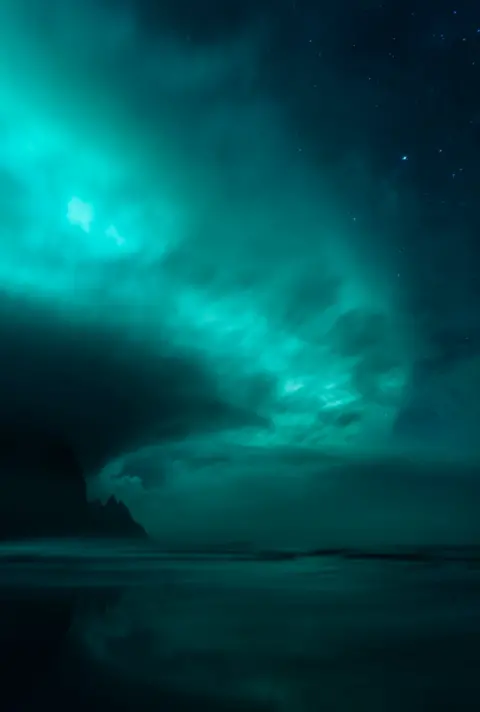 Mikkel Beiter
Mikkel Beiter Runner-up Kamil Nureev caught these green Northern Lights over the Siberian forest tundra.
Nureev says that the lights in his photograph remind him of the mathematical golden ratio.
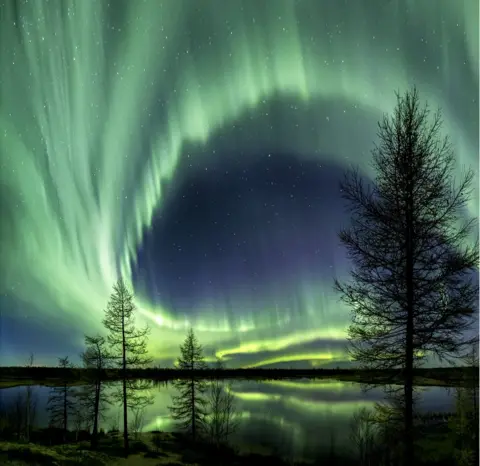 Kamil Nureev
Kamil Nureev
Galaxies
Oleg Bryzgalov's winning image in this category was taken of a spiral galaxy called Messier 63.
The stars of the Sunflower Galaxy, as it is also known, are famously hard to capture. However, by taking this image in one of the darkest places in Europe - the Rozhen Observatory in the Rhodope Mountains, Bulgaria - Bryzgalov successfully photographed them.
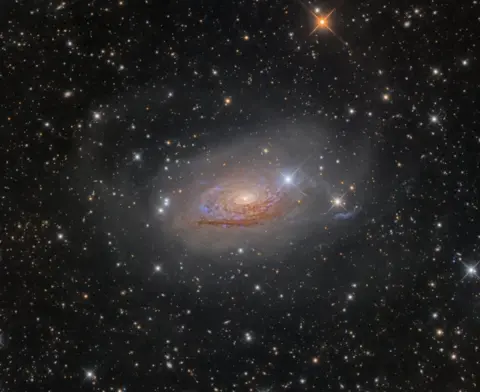 Oleg Bryzgalov
Oleg BryzgalovDespite Bulgaria having a warm winter and early spring, there were snowdrifts of more than one metre high around the observatory.
Bryzgalov fought through the obstacles and managed to capture the galaxy in the Rozhen Observatory's darkness.
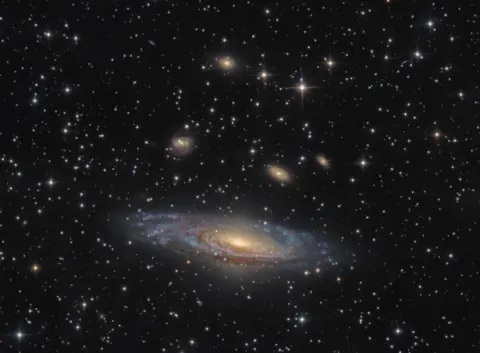 Bernard Miller
Bernard MillerBernard Miller's image is of NGC 7331, a galaxy some 40 million light years away from Earth, in the Pegasus constellation.
"There's an exuberant feeling to this scene, in which tiny galaxies appear to hover above their much larger sibling," says Dr Kukula.
"In reality of course they're no smaller than NGC 7331, just 10 times further away from us."

Our moon
This winning picture by Laszlo Francsics shows the lunar surface in a new, hyper-saturated way.
The Tycho Crater, named after Danish astronomer Tycho Brahe, has a bluish shade. This is typical of the younger craters on the Moon, with estimates dating it as 108 million years old.
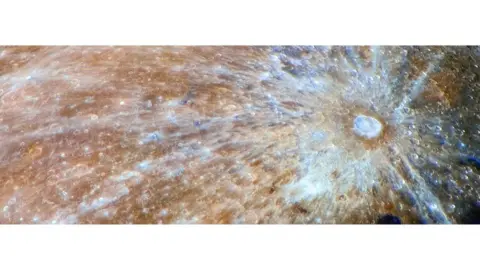 Laszlo Francsics
Laszlo FrancsicsThe runner-up image in this category is Jordi Delpeix Borrell's close-up of the moon's face.
This photograph shows a chain of walled plains - large craters whose floors have been filled with lava.
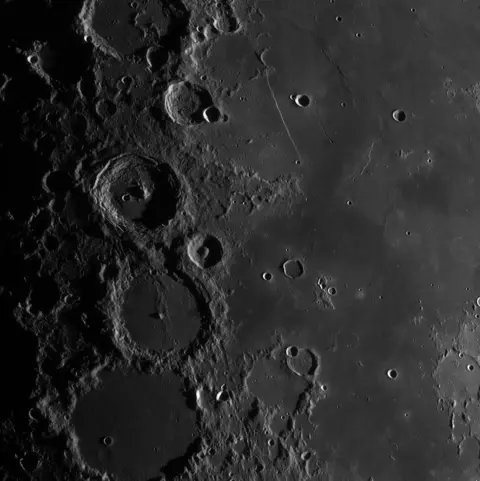 Jordi Delpeix Borrell
Jordi Delpeix Borrell
Our sun
On 9 May 2016, the Transit of Mercury occurred, where the smallest planet in the Solar System passed directly between the Earth and the Sun. It took seven-and-a-half hours - the longest transit of the century.
In Alexandra Hart's winning image, Mercury can be seen towards the centre of our star as a tiny black dot.
 Alexandra Hart
Alexandra HartThe morning of the day of the transit was cloudy, but luckily Hart was able to view the transit from the beginning to just past the midpoint of the sun.
Eric Toops took this striking image of the sun's edge, complete with a sun spot. He layered several images to account for the blurriness caused by the Earth's atmosphere.
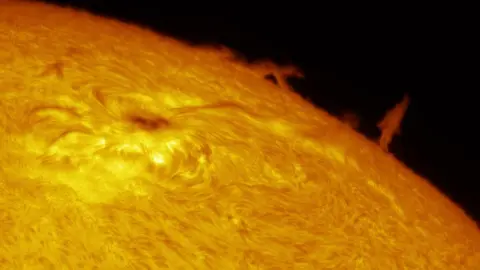 Eric Toops
Eric Toops
People and space
In Yuri Zvezdny's winning image, a lone stargazer stares up at the stars of the Milky Way as they stretch across the night sky.
This photograph was taken over the White Stones glacier in the Los Glaciares National Park, Argentina. Alone in the darkness, Zvezdny made his way across the huge rocks.
 Yuri Zvezdny
Yuri ZvezdnyAlongside a fellow astrophotographer, runner-up Kurt Lawson carried around 110lbs (50 kg) of gear to the summit of Mount Watkins in Yosemite National Park, California.
He then set up his camera for a long exposure, while another friend hiked up the cable route of the Half Dome rock formation. The friend lit the trail with a small lantern and some bright headlamps in order to take this striking image.
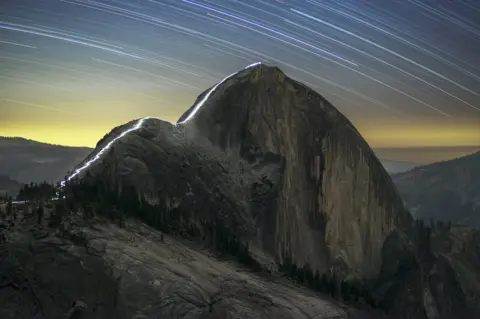 Kurt Lawson
Kurt LawsonThe clear sky allowed the movement of the stars across the night sky to be captured alongside the hiker's path.
The final composite consists of a 64-minute exposure, charting the path up Yosemite's famous granite dome.

Planets, comets and asteroids
Roger Hutchinson photographed this composite image of Venus with the same set-up in order to make its changing faces clear.
In the first image from 25 September 2016, it is seen 86.6% illuminated, whereas six months later only 1% of it can be seen.
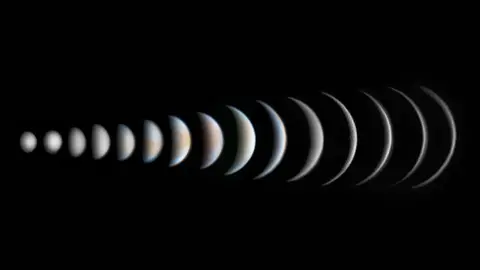 Roger Hutchinson
Roger Hutchinson In this image, the paths of Mars and Saturn are shown swooping through the night sky over a period of 11 months last year. Tunç Tezel photographed the planets on 46 different dates over this period.
The exposures of the photographs ranged from six to 30 seconds according to the changing conditions of the sky, the effects of moonlight and light pollution.
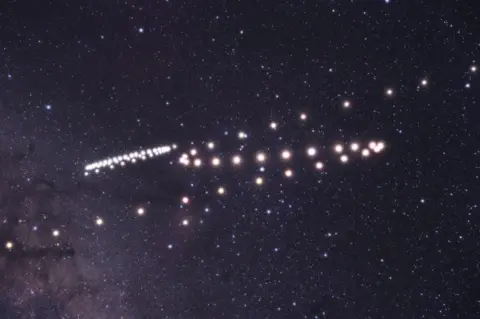 Tunç Tezel
Tunç Tezel
Skyscapes
The dusky Milky Way can be seen through the minimalist outdoor passageway of Lamost (the Large Sky Area Multi-Object Fibre Spectroscopic Telescope) at the National Astronomical Observatory of China in Haitong Yu's winning shot.
It is also known as the Guo Shoujing Telescope, after the 13th century astronomer who was hugely influential in China.
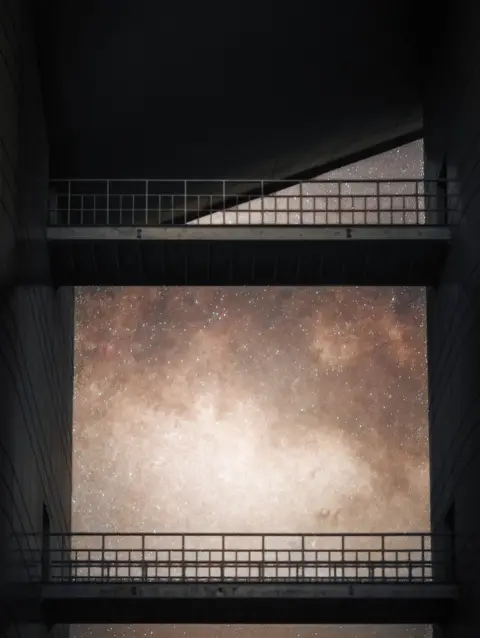 Haitong Yu
Haitong YuZhong Wu depicts the stars beaming down on to the Meili Snow Mountains, also known as the Prince Snow Mountains, the highest peaks in the Yunnan Province, China.
They are world-renowned for their beauty and are some of the most sacred mountains in Tibetan Buddhism.
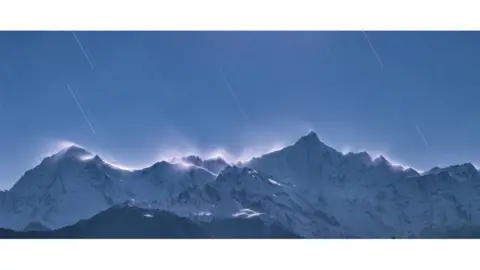 Zhong Wu
Zhong Wu
All photographs courtesy Insight Astronomy Photographer of the Year. Royal Observatory Greenwich
